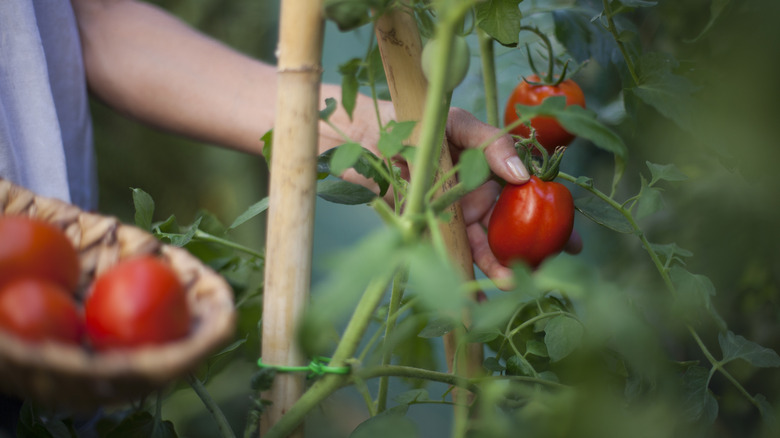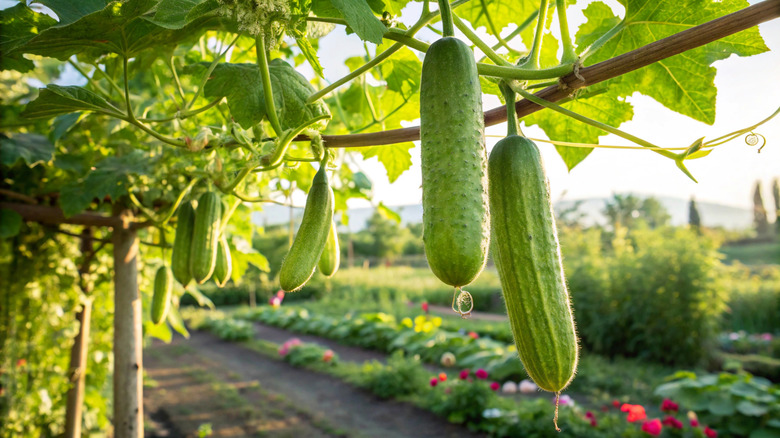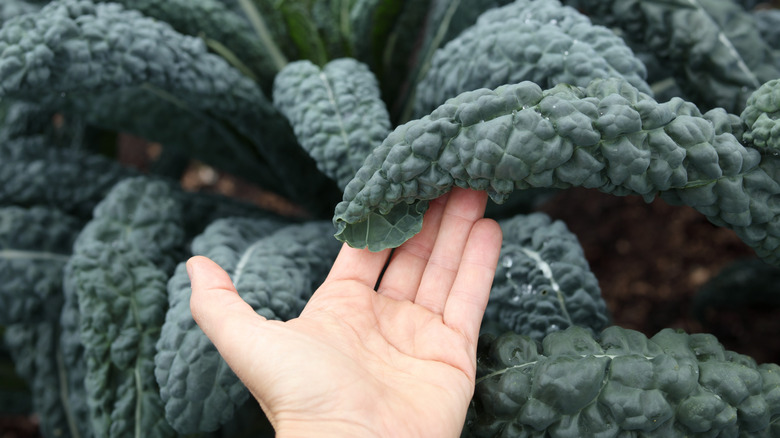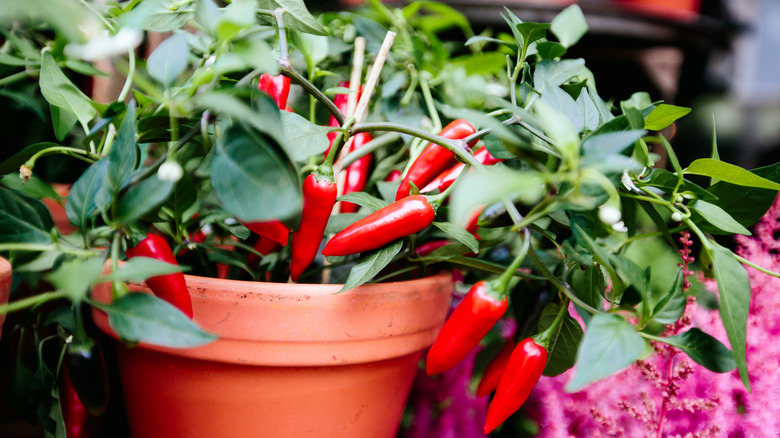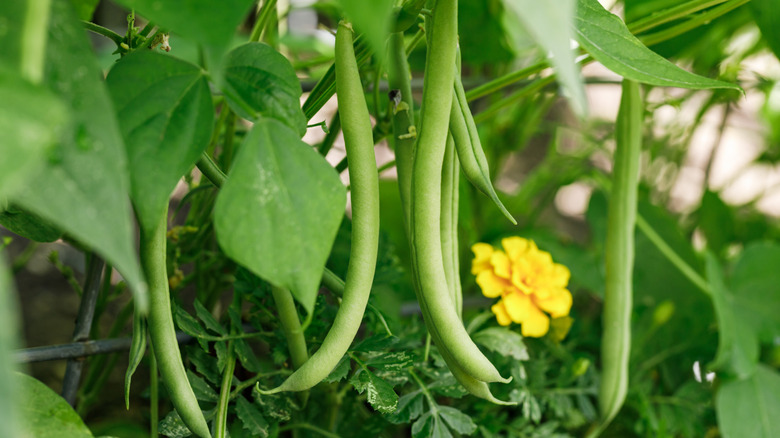How Often Should You Really Be Watering These 5 Common Vegetables In Your Garden?
We may receive a commission on purchases made from links.
Gardening continues to be a popular hobby as people spend time in their yards for the health benefits of lowered stress and exercise. Plus, with the advantage of getting delicious and healthy yard-to-kitchen fruits and vegetables the day they are picked, you can see why it's so popular. The most popular edible plants grown at home are tomatoes, which makes sense with the high cost of heirloom tomatoes at the grocery store.
You may wonder what to grow next if you've already mastered a strong kitchen herb garden. Picking your next fruit or veggie to grow can offer overwhelming choices, and knowing which plants are difficult and which are easy is key. Often, the most challenging part of gardening is watering the plants just right. Too much and the roots can rot, too little and everything is dry and wilted. That's why it's important to understand how to water the most common garden vegetables.
Tomatoes
The biggest benefit of growing tomatoes is the access it gives you to unique varieties that you may not have heard of. They aren't hard to water correctly, but there are some tricky aspects to keep in mind. The easiest way to keep them hydrated is with a drip irrigation system. If you can't set one up, watering with a hose or watering can is just as good, but it's more time-intensive. Sprinkler systems aren't a good choice because when you water tomatoes, you want to make sure you don't get the stems and leaves wet. Water on the plant itself can lead to an increase in pests and diseases, damaging the plant.
It's pretty simple once you've figured out what you're using to water your tomatoes. Water the base of the plant in the morning, when the soil feels dry, so you don't damage the leaves. The earlier, the better because as the day heats up, the soil stays moist and hydrates the plant to counter the temperature. If it's been hot and dry, your plant may need more water. Stick your finger in the dirt to check – if the soil is dry in the top 2-3 inches, it's time to water! Generally, tomato plants need 1-2 inches of water per week. Don't overwater or water inconsistently, as that can lead to cracked tomatoes! To read about more factors that can affect your tomato, read our in-depth guide on growing tomatoes.
Cucumbers
Like tomatoes, cucumbers are composed mostly of water, 96% to be exact, so they need to be watered just right. They require a consistent early-morning watering schedule with 1-2 inches per week. If you water later in the day, the leaves won't have time to dry out by night, increasing their chances of a fungal infection. The root systems of mature cucumber plants go down far, so make sure you water slowly so it can get 6-8 inches down in the soil. Like many plants, make sure you water at the base. Getting water on the leaves can lead to mildew and infections. Make sure to check if the soil is dry. Stick your finger in 1-2 inches; if it's dry all the way down, it's time to water.
With this watering schedule, you can grow all sorts of cucumbers that you typically can't find in stores. And homegrown cucumbers are worth it, imagine picking one straight off the vine to make a tasty and refreshing cucumber salad for lunch.
Kale
While kale is chock-full of healthy nutrients, it can be a controversial meal addition due to its toughness and bitterness. We maintain that if you follow our tips, you can make kale taste delicious and benefit from all those good vitamins and minerals powering your body. It makes sense to grow in your yard as you can choose between a more tender baby kale to put in your bowl as a light leafy green, or a mature kale to sauté as a side.
It's best to give kale around 1 to 1½ inches of water per week, or 1 gallon per square foot. It benefits from moist soil as long as it's not waterlogged. Keeping the soil consistently wet, combined with cold weather, will help develop a sweetness to the green. (If you're growing your kale in a cooler season, make sure you don't overwater!) As with many plants, water at the base so the leaves don't get damaged.
Chilis
Good chili peppers are the most essential part of a hot sauce, and what could be better when making homemade hot sauce than using chilis you grew in your own backyard? It's a good thing that growing chili peppers can be easy! If you live in a place that doesn't have a lot of light and heat, you may be out of luck, though. When you plant your chili, use a fast-draining soil mix.
The key to keeping chili plants properly watered is letting the soil fully dry. Depending on the weather, that can be 2-3 days between irrigations. The soil could dry out in just a day if it's hot and dry. Use the finger test on your soil or buy a soil moisture meter to double-check before you turn on the hose. Like most plants, chilis prefer getting water in the morning so they have time to drink up before the heat dries out the soil, and so it dries out before evening, lessening its chances of fungal diseases.
Green beans
There are many different types of delicious green beans out there. Of all the types available, nothing beats a fresh variety. It's one of the secrets that restaurants use to make tastier green bean dishes. If you have a small garden, planting pole beans, such as green beans, is an excellent option. They grow up a pole and yield quite a lot of beans for the little bit of space they need.
Green beans are a vegetable that likes consistent watering to keep the soil moist (but not soggy). Generally, they want around 1 inch of water a week, depending on the weather. When the soil is dry to a ½ inch down, it's time to water again! As always, a sign your plant needs a round of water is when the leaves start drooping. Beware of overwatering, as well. If the soil feels soggy when you stick your finger in it, it can cause harmful root rot.

